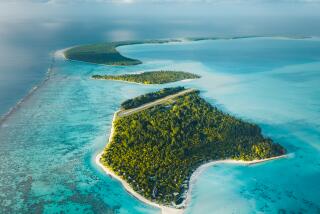15 months, 5 trips, a gut-wrenching sight: How we reported the Marshall Islands story

- Share via
MAJURO, Marshall Islands — Concrete rubble, twisted rebar and rusted anchor chains litter the seabed off the western shore of Nam Island. They are the remnants of a U.S. nuclear bomb test that blew apart this Marshall Islands isle in 1954, and it was here I snorkeled one morning in August 2018 along with Los Angeles Times photographer Carolyn Cole.
We were 4,820 miles southwest of Los Angeles, on our first visit to the Marshalls. We had set out to visually document the brilliance of the reefs — the giant sea turtles, colorful parrotfish, elkhorn coral and blacktip sharks — juxtaposed against the Cold War refuse.
We’d been told that because Bikini Atoll was uninhabitable and so difficult to get to — it took us two days by boat — it was one of the few tropical lagoons left on the planet not suffering from the effects of human proximity: runoff, overfishing and trash.
But as we found so many times during our visit, these islands are full of surprises.

As we rounded the southwestern corner of the island, the clear azure waters of the lagoon disappeared. The sea had been swallowed by a turbid green-brown fog, a bloom of algae surely caused by unusually warm water, 96 degrees at snorkeling level.
What we saw that day was gut-wrenching: The reefs were dead or dying. In all the years I’ve been reporting on climate change, nothing had hit me quite so hard.
When we got back to the boat, Carolyn and I both remained quiet for a time. We had journeyed here to observe a team of Columbia University researchers evaluate radiation levels in the northern atolls. Our plan was to focus on the lingering legacy of U.S. nuclear testing.
But the superheated algae blooms and fish kills prompted a reassessment: Would radiation matter in a generation if the Marshall Islands were enveloped by rising sea levels and lagoons cooked by climate change? That moment ultimately led us to explore deeper questions surrounding the Marshall Islands’ survival and what the United States was doing — or not doing — on behalf of an old Cold War ally.
It wasn’t until we arrived at “the Tomb” that we were finally able to see how these events have come together: Advancing seas and weather were eroding an aging radioactive time bomb, built within and adjacent to a nuclear bomb crater. It highlighted the violence to which these islands were subjected at U.S. hands.
Yet it was the people we met when we got to Ebeye and Majuro who brought this story to life.
Carolyn and I interviewed Marshallese rooted in being uprooted — including some exposed to radiation, relocated, told it was safe to go home, then evacuated again. Others had returned home, but in the strangest sorts of way.

Dick Dieke Jr. recounted how his grandparents had been exiled from Bikini in the 1940s, and now, all these years later, he landed a contractor job as a caretaker on the island. He could stay for only six months before he’s required to leave for a spell, in order to minimize his exposure to the island’s background radiation.
Ali Raj, a Columbia University journalism school graduate, joined the reporting team to explore a cherished aspect of Marshallese culture: their traditional folk music. A trained and passionate musician, Ali had worked for years as a reporter in his native Pakistan before coming to New York. He soon learned of an eerie effect of U.S. nuclear testing — the damage it had inflicted on singers’ vocal cords.
To further tell the stories of people whom Ali interviewed, Carolyn made a return visit to the Marshall Islands in May to shoot more photos and video, and I returned in September.
Back in California (for me and Carolyn) and New York (for Ali), it’s easy to let our protective bubble re-engulf us. If the fall chill makes my house too cold, I turn on my heater. If we get a hot spell, I’ll head to a nearby cafe or the public library to find the cool, air-conditioned temperature where I can work comfortably.
Yet the Marshall Islands show that the comfort and security of the United States have not come without a price. Just as Carolyn and I needed to reassess the story we were reporting, the people of the Marshall Islands are asking the United States to reassess its relationship — or its state of amnesia — with their nation.
As one woman said to me, as I was wrapping up our interview, the seas aren’t rising just on Majuro. They’re rising everywhere.
More to Read
Sign up for Essential California
The most important California stories and recommendations in your inbox every morning.
You may occasionally receive promotional content from the Los Angeles Times.














